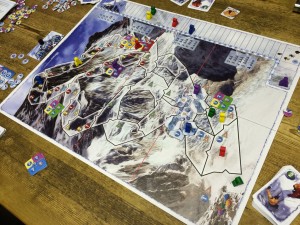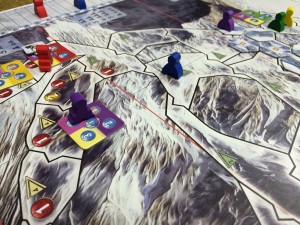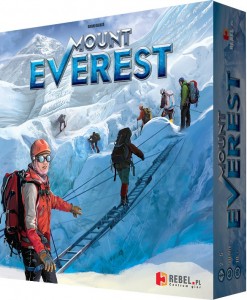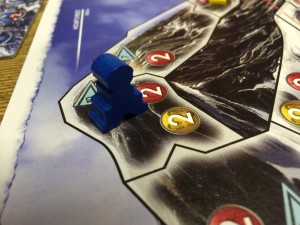Review: Mount Everest
Posted by James (admin) on May 23rd, 2014
 Mount Everest is a game by the designer of K2 which is a great game and you can read my review of K2 for more details. (This review assumes you have not played K2 and I will talk about comparisons at the very end.)
Mount Everest is a game by the designer of K2 which is a great game and you can read my review of K2 for more details. (This review assumes you have not played K2 and I will talk about comparisons at the very end.)
Players each have 2 guides who can escort clients (climbers and tourists) up and down the mountain. Players score Victory Points (VPs) for getting clients to the summit, and more VPs for getting those clients who have reached the summit safely back to base camp. Tourists are worth more VPs but are less hardy than climbers. Your guides can carry tents and oxygen too which are both very useful (in fact, they’re almost vital).
Each guide has a small board showing what they have with them (equipment and clients) but there is very limited space; for example, a guide can take 4 clients and no equipment, or 1 tent and 1 client, or 1 oxygen and 2 clients, etc. So, right from the start, you need to have a strategy on what to take and how to split it between your guides.
The board shows several routes up the mountain each having their pros and cons – one is longer but with smaller steps, another has tougher conditions, etc. Each round, players start with 6 cards in their hand and pick 3 to use – the unused 3 will be part of their 6 cards next round. Each player has a deck of cards and they play these cards on their guides to move them and build tents. Players can also use oxygen bottles they have taken up the mountain to add acclimatisation cards to their deck which increase clients’ acclimatisation levels – this is the only way to get these essential cards into your deck.

After all players have performed their actions, acclimatisation effects are resolved – Clients gain acclimatisation points when at low altitudes and when in a tent, but they lose points when at high altitudes and as a result of the weather. The weather conditions can be seen in advance so players can plan for them. Whilst your guides can never die, your clients will if their acclimatisation reaches zero (scoring a lot of negative VPs ).
So, players need to time their movements very carefully so they can get their clients to the top and back without getting them killed. Whilst players can see the weather conditions at different heights several turns in advance, it’s easy to miscalculate this – Just spending one extra turn at altitude, or in bad weather, can be fatal. It’s made even more of a challenge because you can’t guarantee which cards you will have in your hand – even though you know 3 of the 6 (as those are the ones you didn’t select last turn), you need to ration the different cards because you have to use all 18 cards in your deck before you shuffle them all to make a new deck. It’s easy to use your large movement cards to race up the mountain early on, but then find you only have small movement cards remaining which means you could get perilously stuck in the weather and/or at high altitude.
To add to the challenge, there is a limit to how many guides can end their turn on the same space. So, you can sometimes get blocked by other players (which is all part of the tactics) and this means being near other players’ guides can be dangerous and turn order can also be very important. There is also a potential penalty each round for the player that plays the cards with the highest total movement value so sometimes you need to calculate that into your plan which isn’t always easy.

Mount Everest is a tense game and your plans can quickly come undone. There’s lots to balance such as what equipment, which clients, which route, where to place your tent, when to move to high altitudes, when to be patient, which cards to use/keep, how much time do you prepare at low altitudes, etc. You can also create different strategies for your guides – Do you spend turns preparing by taking equipment up the mountain before starting to take clients, or do a bit of both simultaneously from the start? Do your guides take a mix of equipment and clients, or specialise? However, whilst you need to plan and have a strategy, you also need to react too both to the weather and also to the cards in your hand – if your plan was to strike out for the summit, but you don’t have the movement cards to do it, you may need to come up with a new plan and quick.
The game board and the weather tiles are double-sided with easier (Summer) and harder (Winter) sides; however, even playing with the summer board and weather is still a challenge.
The only negative factor for me is that there is some luck in the draw of the cards and the timing of the weather which can have a big effect. If a player draws cards that time well with the weather (i.e. they get movement cards which allows them to move in sync with the good weather), then it is much easier for them compared to a player who gets low-value movement cards when they need to get out of the way of the weather. Often, you can hang back so as to not head into certain death, but this uses up valuable time and may mean you must go down the mountain before you can go further up. Also, the game can be much harder if the cards you draw are very similar to each other because your tactical choices become limited, such as having lots of low movement cards, or lots of acclimatisation cards at once when you don’t need them (and vice versa).
The luck factor should even out for all players during the game and familiarity with what cards are in the deck will help players plan better so they don’t leave themselves with few options. (If you’re not playing he the maximum players, it’s can be worth laying out one of the non-playing player’s deck of cards face-up so players can see what it contains for reference.) Also, I don’t mind this luck factor because it can’t win the game on its own – a player with bad planning and good luck will not win compared to a player with good planning and bad luck.
You can play K2 using the Mount Everest board, so it’s an expansion for K2 too.
Overall, I enjoyed Mount Everest. There’s a real feeling of tension and a flow of constant, difficult decisions because all movements up into the higher altitudes seem (and are) incredibly perilous. One mess up and your VPs can plunge, but that’s the same for everyone.
You can see some details of the game on Rebel.pl’s Mount Everest page.
James.
[Played with 3 and 5 players]
Comparison to K2
Most of the game mechanics and general principles of Mount Everest are very similar to K2 such as the way you draw and use cards, the weather and acclimatisation, and so on. The core differences are that you’re moving guides who can’t perish with clients who can, and that you starts with no acclimatisation cards so must use oxygen to get acclimatisation cards into your deck. Also, getting part-way up Mount Everest isn’t worth any VPs, unlike K2 where you get VPs for each climber’s ‘highest water mark’.
However, if you’ve played K2, I advise you to read the Mount Everest rules very carefully because it’s easy to assume large and small details (even during set-up) are the same as in K2 when they are not.
The tools and specifics in K2 are different, but the core decision-making, game mechanics and feel of both Mount Everest and K2 are very similar. As a result, both are good, tense (and fairly unforgiving) games; however, they are similar enough that they don’t feel that different to each other.


